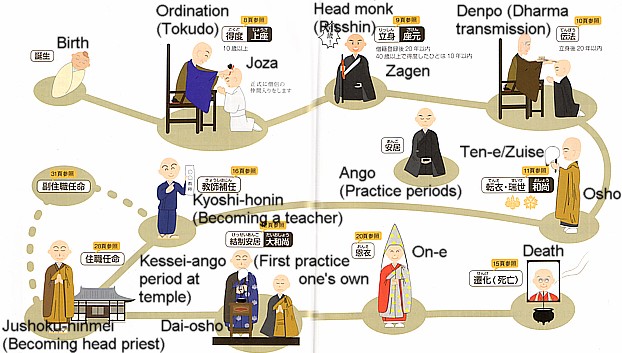Re: Japanese Monk?
It varies from school to school, lineage to lineage, teacher to teacher (like so many "traditions") ...
... but generally in the Soto School, one is considered an "Unsui", meaning “clouds and water”, for many years between the "Home leaving" Ordination ceremony and receiving Dharma Transmission as a Teacher. The best translation in English is “apprentice priest/monk” or "novice priest/monk" or “priest/monk trainee”. One is not considered a full priest, let alone authorized to teach.
Actually, the system in Japan is much MUCH more complicated than that. Here is a chart and discussion of some of the many stages, ceremonies, fee payments (ummm .... "donations"), funny hats, and the like required by the "Soto-shu" in Japan ... a BIG church not unlike the Catholic Church with its own funny hats. Most Lineages in the West have not adopted the majority of these requirements (some have, or have taken other steps to comply with the Soto-shu procedures. Nishijima Roshi generally couldn't give a rat's behind for most of it). Of course, this chart is just about the Soto-shu ... and the Rinzai-shu in Japan has its own ways (varying from Rinzai-shu Lineage to Lineage), and don't even get me started on China which has its own very different stages, ceremonies and requirements!

If you would like more details on the stages, ceremonies, fee payments, funny hats, and the like required by the "Soto-shu" in Japan ... Muho from Antai-ji did a very detailed series of essays recently ...
http://antaiji.dogen-zen.de/eng/lotus10.shtml
Most Western Lineages, like our own, are walking a Middle Way ... keeping the heart of the Traditions, leaving the rest.
Gassho, Jundo
Originally posted by Rev R
... but generally in the Soto School, one is considered an "Unsui", meaning “clouds and water”, for many years between the "Home leaving" Ordination ceremony and receiving Dharma Transmission as a Teacher. The best translation in English is “apprentice priest/monk” or "novice priest/monk" or “priest/monk trainee”. One is not considered a full priest, let alone authorized to teach.
Actually, the system in Japan is much MUCH more complicated than that. Here is a chart and discussion of some of the many stages, ceremonies, fee payments (ummm .... "donations"), funny hats, and the like required by the "Soto-shu" in Japan ... a BIG church not unlike the Catholic Church with its own funny hats. Most Lineages in the West have not adopted the majority of these requirements (some have, or have taken other steps to comply with the Soto-shu procedures. Nishijima Roshi generally couldn't give a rat's behind for most of it). Of course, this chart is just about the Soto-shu ... and the Rinzai-shu in Japan has its own ways (varying from Rinzai-shu Lineage to Lineage), and don't even get me started on China which has its own very different stages, ceremonies and requirements!

If you would like more details on the stages, ceremonies, fee payments, funny hats, and the like required by the "Soto-shu" in Japan ... Muho from Antai-ji did a very detailed series of essays recently ...
http://antaiji.dogen-zen.de/eng/lotus10.shtml
Most Western Lineages, like our own, are walking a Middle Way ... keeping the heart of the Traditions, leaving the rest.
Gassho, Jundo

 But, you are right.
But, you are right.
Comment